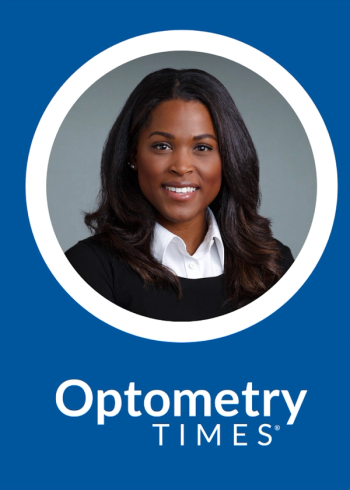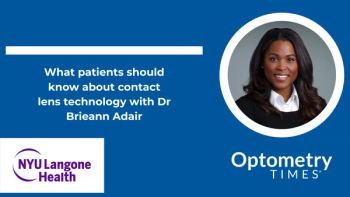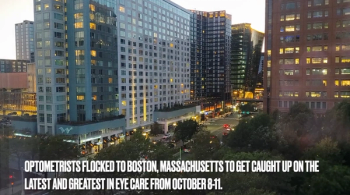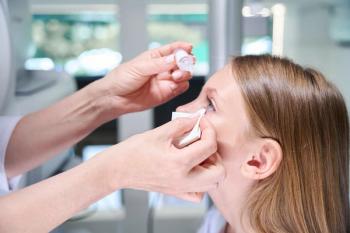
Transcript: Contact lens wear is a healthy option for kids
New data shows that contact lens wear is a healthy option for kids as young as age 8
Gretchyn Bailey: Hi, everyone. I am Gretchyn Bailey with Optometry Times®, and today I have the pleasure of speaking with Dr. Jill Woods. Jill is head of clinical research for the Center for Ocular Research and Education, or CORE, and she is lead author on a new paper that has just come out talking about contact lens wear in children. So, Jill, thank you very much for talking with me today. How are you?
Jill Woods, MSc, MCOptom, FAAO: You are welcome. Happy to be here, Gretchyn.
Bailey: This paper is telling us that contact lens wear is a safe option in younger kids. And I know we have talked about that a lot in the contact lens aspect of the industry. But now you have some data to back that up. Can you tell me a little bit about the study and what you have found?
Study details
Dr. Woods: Yes, absolutely. So, this study primarily aimed to look at myopia control and test the MiSight (CooperVision)corrective lens. It was initially set up to be a 3-year study and got extended to 6 years. It is great that we now have the 6 years; it makes it the longest pediatric contact lens study ever. And it gives us great data. There is a lot of MiSight myopia control data there, but my paper and manuscript were looking at the safety aspects with children. When we started, I think we saw our first child participant in February 2013.
Bailey: Oh, wow!
Dr. Woods: We saw the last one in February 2020, which was really good timing because then, of course, we all shut down in March 2020. So, I would have hated to be the site that held up the final data analysis on this important study. But yes, we were one of 4 sitesin this study. And we enrolled the most participants. It was a great, pivotal study to be involved in. Children were recruited from age 8 to 12 at the beginning, and as I said, we followed them for 6 years in total.
My manuscript that you referred to focuses on that safety piece. In any clinical trial, we are assessing the subjects very closely. This trial was no different. We saw them very frequently. In the first 6 months of the study, we were teaching them to handle the lens, and we saw them regularly. After 6 months, we saw them every 6 months after that. Each of those visits involved a careful slit lamp examination, both with the lens on and then with the lens off.
Bailey: So you looked at 144 children.
Dr. Woods: We were looking at the usual things that you would look at in practice: limbal hyperemia, conjunctiva, hyperemia, corneal integrity, corneal staining, tarsal redness, tarsal roughness, the usual realm of things, as well as the vision and other pieces to do with the trial. What we found (some of the take-home messages from this study) is that the slit lamp assessments that we conducted in the beginning,were really no different to those slit lamp assessments that we were seeing after 6 years of full-time contact lens wear. So, that is a big message, I think, for practitioners to understand. There was really no long-term impact of contact lens wear, and these children were wearing them full-time. They were wearing them for 13 hours a day more than 6 days a week. So that really is full time. I won’t get too much into that. We required them to wear the lenses for 10 hours a day, 6 days a week, to get the myopia control impact. But they weren’t worn beyond that. They really enjoyed the option of wearing contact lenses. So that was good.
Bailey: Yes.
Parental assistance
Bailey: Because you were studying CooperVision's MiSight myopia control contact lens that helped you get those—I mean, you had your built-in kids right there; you didn’t have to start a new study to take a look at safety. My big question is: were you assessing if the children themselves were handling and caring for the lenses because I know sometimes parents get involved with application, removal, and hygiene. So, how did that play out in this study?
Dr. Woods: Right. And that is a great point. We were anticipating spending a lot of time teaching the children how to handle them. We wanted them to be independent, particularly at removing the lenses. If they are out at school in the day, they have to be confident and capable of removing those lenses for safety reasons. So, no one was allowed to leave unless they could remove the lenses independently. We did allow a little bit of assistance from parents in applying the lens to the eye. But to be honest, children are very good at picking that up. They have no fear. And a couple of times, we had to slow them down. They would go, ”Yeah, I can get that in“ and it’s like, WWhoa, stop!, We’ll get that hand back in a minute. Just think about it and slow is good, slow is good.” But they have very little fear, and their handling wasn’t really an issue. And we had all sorts of ethnicities, eye shapes, narrow palpebral apertures, big eyes, big fingers, small fingers. And it wasn’t an issue.
Bailey: So let’s talk about any adverse effects. Did any kids show any trouble? Did you see any microbial keratitis (MK)? Did you see any trouble with kids applying them or conjunctival problems with kids thinking that they had the lens in the eye, but they actually didn’t, and all the concerns that people usually have about kids wearing contact lenses?
Adverse effects
Dr. Woods: Yes, and I think there are some important messages in that data that we picked up. We were, as I say, looking at everything when the child came in every 6 months, and the investigators on the study were instructed to report anything as an adverse event. I think when you are comparing across different research studies and the data, it is important to know how those events are classified. Now, there are going to be adverse events in any study of this length of time. And children are children, whether they wear contact lenses or not. So, you are going to get appendicitis, you are going to get a broken arm, you are going to get this, that, and the other. So, the manuscript focuses on the ocular adverse events.
When we look at the patients that we had, and the participants that we had in this study, they add up to 653 contact lens-wearing years, which is a big number.
Bailey: Absolutely.
Dr. Woods: And in that time, we had 40 ocular adverse events, only 22 of those were identified as being contact lens-related. So, you are going to get a conjunctivitis here or there. But everything was reported. Some of them were related to the contact lens. Some of them were not. We had no serious contact lens-related adverse events. And that is always the big worry, we had no MK, nothing of that serious sight-threatening nature.
We did have one serious ocular adverse event, which was related to a herpes zoster infection, that was not regarded as being contact lens-related.
Bailey: Right. And if we look at the kind of contact lens-related ocular adverse events, they were nothing that a regular practitioner could not manage themselves. We had conjunctival hemorrhage, we had redness, we had an itchy eye, we had an allergic response, we reported headaches as an adverse response, even blurry vision was recorded as an adverse response if that was a presenting symptom. So, we did try and catch every possible thing that wasn’t normal as an adverse response. We ended up with just 22 contact lens-related ones.
Bailey: That is a great number. Very low.
Dr. Woods: Yes, we wouldn’t want it to be much higher.
Study results
Bailey:Absolutely. Do you think that the results of this study will be more reassuring to practitioners or to parents?
Dr. Woods: Both, I think. When you think of this size group of children, we had 90 days to finish. And this number of years, you might expect a little bit more of the itchy eye, sore eye coming in. But really, 22 is a very small number, and the type of adverse events were totally manageable. So, I think that should give practitioners confidence in fitting this age group. In fact, they were as young as 8 when they started this study. It is manageable. Children want to wear contact lenses, not just for myopia control, let’s not forget the hyperopes out there. They might love to ditch their specs for sports or any other reason, right?
So, the results reach much wider than just myopia control. But it does inform the parents of the options and the risks around myopia control options of the myopic children. So, parents can glean information from this study, but it also gives a good basis for conversation for practitioners to have with the parents.
Bailey: Do you anticipate sharing results of this study with consumer or parent outlets such as a parent magazine or pediatrician groups? Or trying to get the word out to parents as opposed to simply practitioners?
Dr. Woods: That is probably a good idea. It is something we have not thought of at CORE. Obviously, the study was sponsored by CooperVision. And they have a lot of avenues to get messaging out, they have the Bright Stars program and various things. There may be some value in doing that. And sharing the data, as you say, it is the parent that makes the decision for these children, whether it is myopia control, or for any other reason that they are thinking of contact lenses. So, the more information they can have the better.
OD takeaway
Bailey: Absolutely. And if you had to offer a takeaway or 2 to practitioners about this study, what would you say to them?
Dr. Woods: I would say that the results are very encouraging. A lot of practitioners will not consider fitting contact lenses to anybody under the teen years. And maybe even 13, 14 might be a bit young for them. But I would encourage them and say, ”It is quite easy to fit children. They are very receptive. They are very good at listening and learning. So the safety around their handling, they generally do as they are told.” I recognize that may be for other people, maybe not for the parents.
But I recognize that the cohort we had in this study, there was some parental supervision at that age, obviously, including reminders to wash hands. And we had a little handout sheet as a reminder. Every time we saw them, we asked them to answer some safety questions such as: ”Should you wash your hands before you take your contact lenses outIs that true or false?” You know, “Should you swim in your contact lenses? Is that true or false?” We gave them a lot of instruction at the beginning and a lot of reinforcement on the safe way to wear contact lenses. Do not wear them to swim, do wash your hands before you put them in, do wash your hands when you take them out. That kind of thing.
So, I think the take-home is not to be worried about fitting children. The response was as good or better than adults.
Bailey: I think that is a very good take-home message. Kids are as good or better than adults with caring for their lenses. That is good to remember. Well, thank you very much for talking with me today. It was a pleasure to see you. And thanks very much for your time.
Dr. Woods: Thank you, Gretchyn.
Newsletter
Want more insights like this? Subscribe to Optometry Times and get clinical pearls and practice tips delivered straight to your inbox.








.png)


